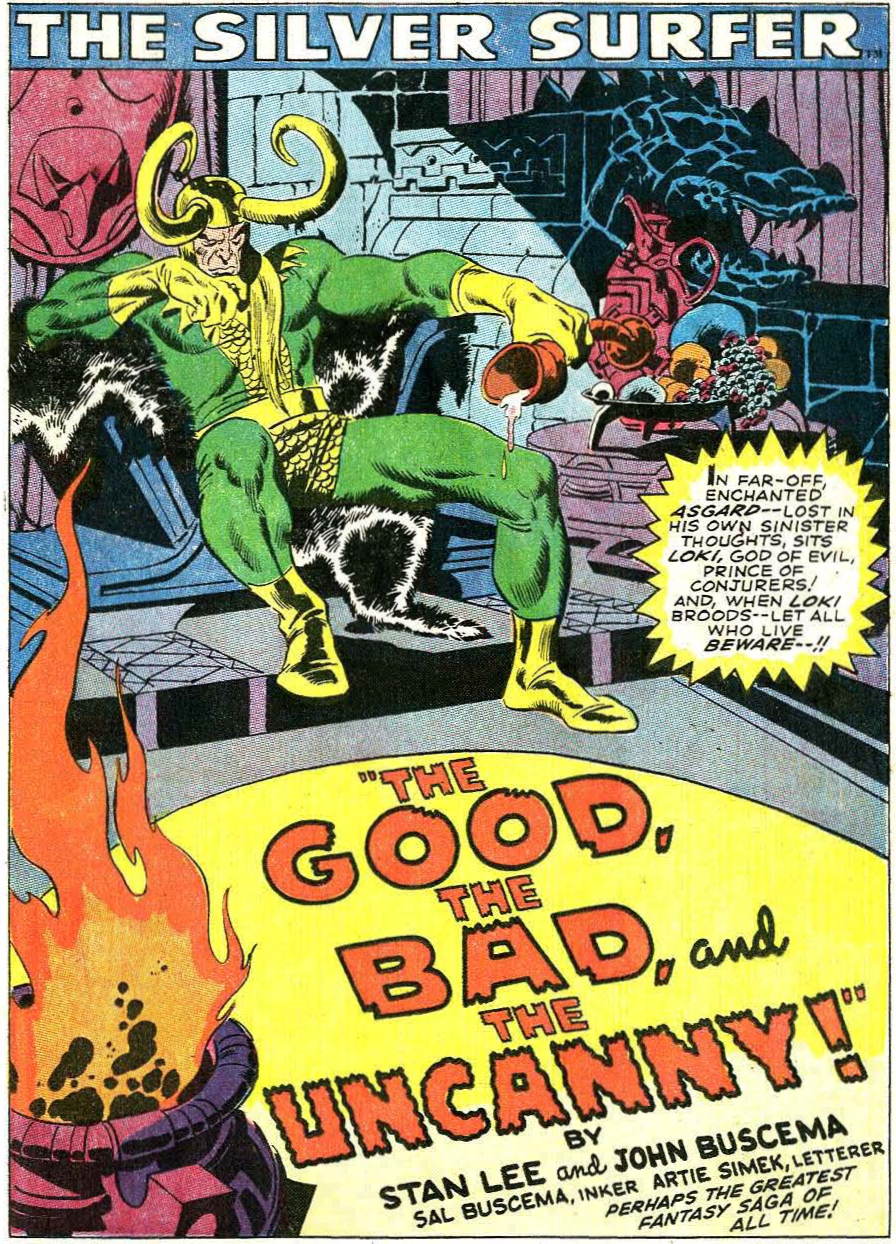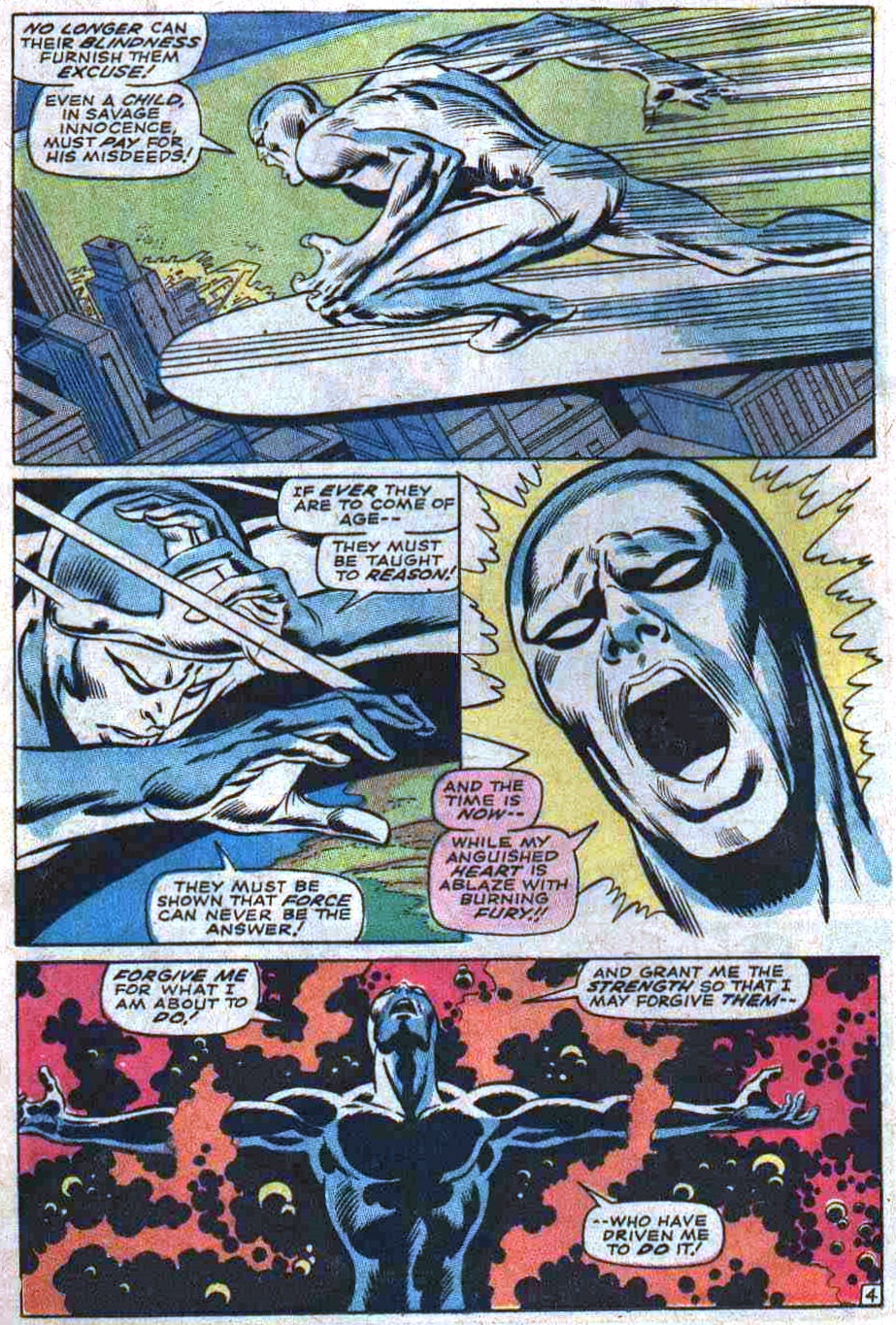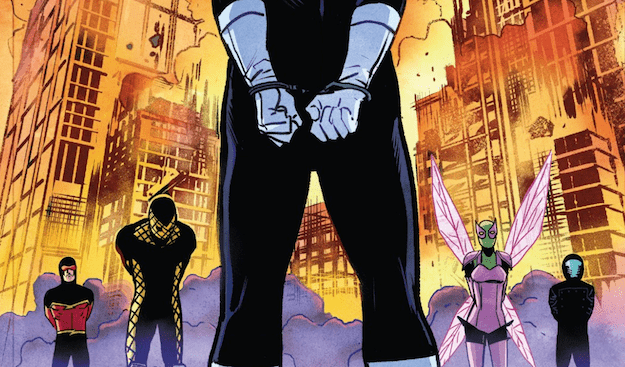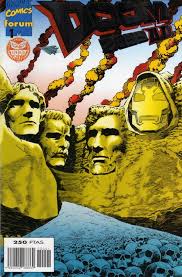|
|
Post by Deleted on Dec 20, 2023 11:04:46 GMT -5
#5 – Daughters of the Dragon #1–6 (2006) Looks like another one to check out.....ta! |
|
|
|
Post by Deleted on Dec 20, 2023 11:06:02 GMT -5
I have no underground comics....I'm still trying to differentiate between 'underground' and small-press, I mean would a book with a 200-issue print run for Patreon subscribers be considered underground? If so, then RAGS is underground hehe....
|
|
|
|
Post by Prince Hal on Dec 20, 2023 11:09:06 GMT -5
Day Eight
Silver Surfer 1-8, 1968-69The more I write these kinds of posts, the more I realize that quite a few of my comic book favorites, no matter the category, remained favorites for only a portion of their run. Many factors cause that kind of short-term fascination. Sometimes it’s a change of artists, but it’s often also a result of the title slipping into the so-so category, as in: “Same old, same old.” Looking back to the heyday of my comics reading, I recall my disappointment as titles that began in a burst of excitement and uniqueness gradually, sometimes quickly, ran out of steam and grew static. That was definitely the case with Silver Surfer. I was only 14, so I didn’t know from existentialism or angst, or at least those words for the feelings I shared with the Surfer, but I knew I hadn’t read anything like his anguished musings in a comic book. And, yes, looking back even twenty years after having read those the first time, let alone over fifty, I can see that Stan Lee’s dialogue and thought balloons were a histrionic, melodramatic, bathetic, pseudo-Shakespearean, consciously Biblical gallimaufry, but that stew of high-falutin’ prose seemed just right for the epic scope of the Surfer’s story. (Even I was less cynical back then.) The Surfer’s story was essentially an opera, with the Surfer singing astral arias for page after page, and if I didn’t quite understand everything he was agonizing about, well, a lot of people listening to Pagliacci singing didn’t understand the Italian, but they could tell just how deeply the poor guy’s emotions ran. And despite the lack of action in those segments, the storytelling was dynamic. Because like a great opera singer’s, the Surfer’s face also told the story, thanks to the skills of John Buscema and his imaginative use of the Surfer’s deceptively simple design. Was Buscema ever better than in these first few issues of Silver Surfer? He freed Norrin Radd from within Kirby’s rough, expressionless Surfer, trapped in his silver shell. Buscema’s humanization of the Surfer reminds me of the answer Michelangelo supposedly gave by when asked how he carved marble into statues. “Every block of stone has a statue inside it and it is the task of the sculptor to discover it, “he said. “I saw the angel in the marble and carved until I set him free.” And in his drawings of the Surfer, Buscema achieved much the same, freeing not an angel, but the human being Norrin Radd in illustrations of a being as supple and expressive as one of Michelangelo’s marble statues, capturing all of the agony and confusion that Norrin Radd felt in beautifully rendered close-ups of his face. Those first issues were a bit like those of another tortured soul, Alec Holland, in the first Swamp Thing run: excursions into various genres where Buscema in particular could let loose: an alien invasion; Frankenstein’s castle; Asgard; Hell itself; and of course, the vastness of space. And the size and page-length of those stories added to the epic feel. You sat down to read these double-length extravaganzas (None was shorter than 38 pages!) and were taken away for what seemed like hours. Spreading these out over two or three issues would have been like seeing only the first act of “Otello” and coming back two months later for Act Two. Part of the power of the stories was that you could become immersed into their world completely without fear of an artificial interruption.   Of course, the inevitable fate of the title occurred with the eighth issue, when the page count was reduced by half and a couple of stories intended for the longer length were chopped in two. Making things worse was that because comic book characters never truly change, the Surfer was stuck in the Weisinger Zone, even though readers were now sticking around longer than a couple of years, getting more mature and looking for characters to grow. The Surfer soon became just another comic book hero, stuck in an eternal present, unchanging and, because he was a Marvel hero, self-absorbed. What had been a story of questioning and grandeur was reduced to griping and banality.
|
|
Confessor
CCF Mod Squad
Not Bucky O'Hare!
Posts: 10,199  Member is Online
Member is Online
|
Post by Confessor on Dec 20, 2023 11:14:36 GMT -5
I have no underground comics....I'm still trying to differentiate between 'underground' and small-press, I mean would a book with a 200-issue print run for Patreon subscribers be considered underground? If so, then RAGS is underground hehe.... I'm sure there are others better qualified to answer this than I, but to me, underground comix are something that has always been linked to the counter-culture -- particularly the hippie counter-culture of the late '60s and '70s. While they are self-published or small press runs, that's not what defines them, as far as I'm concerned; it's more that they feature subversive, anti-establishment material, often alongside sexually explicit content and open drug use, which would never have been allowed under the watch of the Comics Code Authority. So, it's not just that they had small, self-published runs that defines underground comix; it's much more about the nature of their content and its presence outside the purview of the Comics Code Authority. Since the CCA no longer exists, I'm not really sure its possible today for underground comix as a genre to even exist. |
|
|
|
Post by MRPs_Missives on Dec 20, 2023 11:17:17 GMT -5
I'd say it's a case of undergrounds usually being small press comics but not all small press comics are undergrounds. Small press usually refers to scale of production, while underground usually refers to content and/or means of distribution. But then I'm not an expert and I'm making this up based on my observations and experience working with the small press community in Ohio.
-M
|
|
|
|
Post by EdoBosnar on Dec 20, 2023 11:38:40 GMT -5
(...) I summon the brain fart!
You keep doing that, I keep telling you it's not a good idea... |
|
|
|
Post by Slam_Bradley on Dec 20, 2023 12:30:47 GMT -5
On the Eighth Day of Christmas, Sandman gave to me, a master of Deviltry.  Lucifer Lucifer We've seen him before, because I have a basic white guy list. I was skeptical of most of the stuff that spun out of Sandman. And rightly so. Not that there wasn't good stuff there, but when you're coming out of one of (in my opinion the) best funnybooks ever, you have a lot to live up to. Well Mike Carey (who I was unfamiliar with at the time) was able to live up to that legacy. While not as good overall as Sandman, Lucifer is an outstanding book in its own right. If Sandman is about stories, then Lucifer is a meditation on free-will versus predestination. Lucifer is the ultimate manifestation of free-will, rebelling against the Heavenly plan and then rebelling again against the strictures and structures of ruling in Hell. Are we bound by where we came from? Can we escape the past and forge our own reality? Or are we simply creatures who are motivated by biology and the experiences that formed us? Lucifer looks at that...and we are allowed to decide for ourselves. |
|
|
|
Post by coke & comics on Dec 20, 2023 12:33:36 GMT -5
The Eighth Day of Christmas: This Conductor doesn’t run the North Pole Express-M is such a great choice that I now find myself unable to explain why it's not on my list. I am sure I thought about it while making the list. But I think it got a bit lost in the shuffle that is my brain. |
|
|
|
Post by commond on Dec 20, 2023 16:39:39 GMT -5
#5 Superior Foes of Spider-Man #1-17 (2013-2015)Spun off from Superior Spider-Man (itself a spin-off of Amazing Spider-Man.)  I just read this recently. It's very much in the sitcom mode of comic book writing. It's most commonly compared to It's Always Sunny in Philadelphia. I don't have access to that show on my streaming services, but you get the general idea. Lovable loser, Boomerang, narrates this story of a Sinister Six with five members who are desperate to pull off that one big score that will make them the most feared and admired gang in New York. Most of the hijinks revolve around a stolen painting of Doctor Doom without his mask on, and the talking head of former Maggia crime boss, Silvermane. It's a tale full of double crosses, humiliation and embarrassment, and even a little bit of redemption, with a bunch of funny jokes along the way. Not everyone likes humor in their comic books, I know. They could have played this straight but it wouldn't have been half as fun. Why wallow in pity when you can have a chuckle about it?
|
|
|
|
Post by thwhtguardian on Dec 20, 2023 17:12:11 GMT -5
5. Star Trek: Leonard McCoy, Frontier Doctor(4 issues, IDW 2010) I very nearly went with this, I loved this book while it was coming out but wasn't sure if it precisely counted so it just missed. |
|
|
|
Post by thwhtguardian on Dec 20, 2023 17:43:45 GMT -5
On the Eighth day of Classic Comics Christmas I'm going with... #5: Miles Morales  This is a spin off that a lot of what I loved about it(aside from the fun writing and amazing art) was that I really felt that I was getting in on the ground floor so to speak while picking this up. From his first panel in Ultimate Fallout #4 I just felt like this was a character that was really going to be special, and man was he ever. I loved Bendis' Ultimate Spider-Man because it gave us a modern Peter Parker, but he went further here by not just giving us a teenage Spider-Man again but a teenage Spider-Man that actually felt like a realistic teen. It wasn't just the trappings of teen life like school and young love, it actually dealt with the drama up having to sit through a school lottery and balancing the emotions of getting in versus the disappointment you feel when you look around and see the faces of everyone who didn't. It had a real slice of life feel to it that was perfectly balanced with some really slick super heroics. |
|
|
|
Post by coke & comics on Dec 20, 2023 17:58:37 GMT -5
On the Eighth day of Classic Comics Christmas I'm going with... #5: Miles Morales Brilliant choice. Didn't even occur to me. And I just rewatched Across the Spider-Verse last night. Best movie of the year. |
|
|
|
Post by wildfire2099 on Dec 21, 2023 0:17:16 GMT -5
I've never seen that Dr. McCoy series... sounds really interesting My choice today is another popular one. 5. Doom 2099  This came out back when I still thought Warren Ellis was brilliantly clever and original, I was SO excited to see Doom actually win! How cool is that! What really made the series though was the character interactions... I know most of the virtual stuff in 2099 was a bit hokey, but I loved Wire for some reason. |
|
|
|
Post by coke & comics on Dec 21, 2023 3:24:48 GMT -5
This came out back when I still thought Warren Ellis was brilliantly clever and original, I was SO excited to see Doom actually win! How cool is that! What really made the series though was the character interactions... I know most of the virtual stuff in 2099 was a bit hokey, but I loved Wire for some reason. I'd never heard of Ellis prior to this. And I still didn't really take note of his name at the time. I learned who he was when he started doing the X Books, I think. |
|
|
|
Post by MDG on Dec 21, 2023 9:24:29 GMT -5
I have no underground comics....I'm still trying to differentiate between 'underground' and small-press, I mean would a book with a 200-issue print run for Patreon subscribers be considered underground? If so, then RAGS is underground hehe.... I'm sure there are others better qualified to answer this than I, but to me, underground comix are something that has always been linked to the counter-culture -- particularly the hippie counter-culture of the late '60s and '70s. While they are self-published or small press runs, that's not what defines them, as far as I'm concerned; it's more that they feature subversive, anti-establishment material, often alongside sexually explicit content and open drug use, which would never have been allowed under the watch of the Comics Code Authority. So, it's not just that they had small, self-published runs that defines underground comix; it's much more about the nature of their content and its presence outside the purview of the Comics Code Authority. Since the CCA no longer exists, I'm not really sure its possible today for underground comix as a genre to even exist. Yeah--I see the real undergrounds as being a time-bound phenomena, when really, just the idea of producing material for adults--as well as "adult material"--in the format (size and newsprint) as regular comic books was totally unheard of. Basically, that period ended around '75 or so, with the publication of Arcade magazine, the creation of the direct market, and the growth of comic shops. |
|